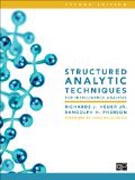
Structured Analytic Techniques for Intelligence Analysis
Heuer Jr., Richards J.
Pherson, Randolph H.
In this Second Edition of Structured Analytic Techniques for Intelligence Analysis, authors Richards J. Heuer Jr. and Randolph H. Pherson showcase fifty-five structured analytic techniques—five new to this edition—that represent the most current best practices in intelligence, law enforcement, homeland security, and business analysis. INDICE: Chapter 1: Introduction and Overview 1.1 Our Vision 1.2 Two Types of Thinking 1.3 Dealing with Bias 1.4 The Role of Structured Analytic Techniques 1.5 The Value of Team Analysis 1.6 The History of Structured Analytic Techniques 1.7 Selection of Techniques for This Book 1.8 Quick Summary of ChaptersChapter 2: Building a System 2 Taxonomy 2.1 Taxonomy of System 2 Methods 2.2 Taxonomy of Structured Analytic TechniquesChapter 3: Choosing the Right Technique 3.1 Core Techniques 3.2 Five Habits Every Analyst Should Master 3.3 One Project, Multiple Techniques 3.4 Common Errors in Selecting Techniques 3.5 Structured Technique Selection GuideChapter 4: Decomposition and Visualization 4.1 Getting Started Checklist 4.2 AIMS (Audience, Issue, Message, Storyline) 4.3 Customer Checklist 4.4 Issue Redefinition 4.5 Chronologies and Timelines 4.6 Sorting 4.7 Ranking, Scoring, Prioritizing 4.8 Matrices 4.9 Venn Analysis 4.10 Network Analysis 4.11 Mind Maps and Concept Maps 4.12 Process Maps and Gantt ChartsChapter 5: Idea Generation 5.1 Structured Brainstorming 5.2 Virtual Brainstorming 5.3 Nominal Group Technique 5.4 Starbursting 5.5 Cross-Impact Matrix 5.6 Morphological Analysis 5.7 Quadrant Crunching™Chapter 6: Scenarios and Indicators 6.1 Scenarios Analysis 6.2 Indicators 6.3 Indicators ValidationChapter 7: Hypothesis Generation and Testing 7.1 Hypothesis Generation 7.2 Diagnostic Reasoning 7.3 Analysis of Competing Hypotheses 7.4 Argument Mapping 7.5 Deception DetectionChapter 8: Assessment of Cause and Effect 8.1 Key Assumptions Check 8.2 Structured Analogies 8.3 Role Playing 8.4 Red Hat Analysis 8.5 Outside-In ThinkingChapter 9: Challenge Analysis 9.1 Premortem Analysis 9.2 Structured Self-Critique 9.3 What If? Analysis 9.4 High Impact/Low Probability Analysis 9.5 Devil’s Advocacy 9.6 Red Team Analysis 9.7 Delphi MethodChapter 10: Conflict Management 10.1 Adversarial Collaboration 10.2 Structured DebateChapter 11: Decision Support 11.1 Decision Trees 11.2 Decision Matrix 11.3 Pros-Cons-Faults-and-Fixes 11.4 Force Field Analysis 11.5 SWOT Analysis 11.6 Impact Matrix 11.7 Complexity ManagerChapter 12: Practitioner’s Guide to Collaboration 12.1 Social Networks and Analytic Teams 12.2 Dividing the Work 12.3 Common Pitfalls with Small Groups 12.4 Benefiting from Diversity 12.5 Advocacy vs. Objective Inquiry 12.6 Leadership and TrainingChapter 13: Validation of Structured Analytic Techniques 13.1 Limits of Empirical Analysis 13.2 Establishing Face Validity 13.3 A Program for Empirical Validation 13.4 Recommended Research ProgramChapter 14: The Future of Structured Analytic Techniques 14.1 Structuring the Data 14.2 Key Drivers 14.3 Imagining the Future: 2020
- ISBN: 978-1-4522-4151-7
- Editorial: CQ Press
- Encuadernacion: Rústica
- Páginas: 384
- Fecha Publicación: 31/07/2014
- Nº Volúmenes: 1
- Idioma:
